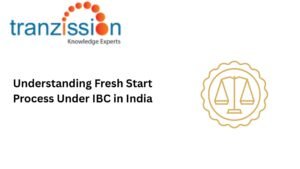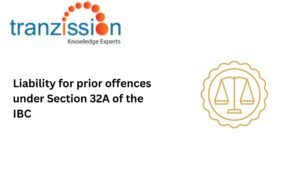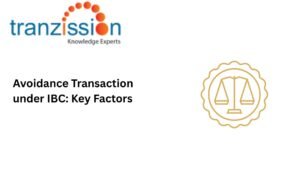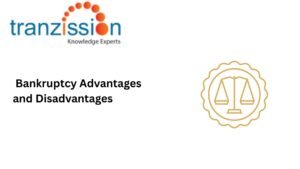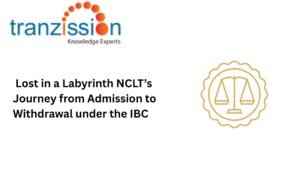
Role of NCLT in insolvency proceedings
Table of Contents
The National Company Law Tribunal (NCLT) and the National Company Law Appellate Tribunal (NCLAT) are governed by the Companies Act, 2013, the Insolvency and Bankruptcy Code, 2016, and the Insolvency and Bankruptcy Board of India (Insolvency Resolution Process for Corporate Persons) Regulations, 2016. Both are pivotal in insolvency resolution and the liquidation process of corporate persons, playing a crucial role of NCLT in insolvency proceedings by adjudicating applications, appointing resolution professionals, and approving resolution plans.
What is the National Company Law Tribunal?
NCLT is quasi-judicial authority incorporated for dealing with corporate disputes that are of civil nature under the Companies Act, such as oppression and mismanagement, and winding up of companies. The National Company Law Tribunal (NCLT) is the Adjudicating Authority in the insolvency process and is the constituted under section 408 of the Companies Act 2013, as defined under the section 5(1)Insolvency and Bankruptcy Code, 2016 (hereon forward known as the “IBC”). The NCLT is constituted by the Central Government through a notification and comprises the President and Judicial and Technical members that the Central Government deems necessary.
Jurisdiction of National Company Law Tribunal
Under section 60(1) of IBC, the NCLT has territorial jurisdiction over the place where the registered office of the corporate person is located. An application for voluntary liquidation by the corporate debtor, the NCLT shall pass an order to dissolve the corporate debtor as per section 59(8). As per section 60(4), the NCLT is vested with the powers of the Debt Recovery Tribunal for Part III of the IBC. As per this, the NCLT has the authority to deal with the applications relating to insolvency resolution or bankruptcy of a personal guarantor of a corporate debtor.
Admission of Insolvency Resolution Application before NCLT
There are three corporate persons who can initiate the resolution application before the NCLT, the financial creditor, operational creditor, and the corporate debtors themselves through an online portal https://ibbi.gov.in/en/intimation-applications/iaaa.
1. Financial creditor
Under section 7 of IBC, the financial creditor can file an application for initiation of the corporate insolvency resolution process (CIRP) before the NCLT when a default occurs. This default is about the financial debt owed to the financial creditor who has filed the application, but also the financial creditors of the corporate debtor. The financial creditor must submit the necessary details as per Form 1 of the Insolvency and Bankruptcy (Application Authority) Rules, 2016
List of Documents Required by the Financial Creditor
The documents are required for a financial creditor to file an application with the NCLT is listed under section 7(3) of IBC and the Insolvency and Bankruptcy Board of India (Insolvency Resolution Process for Corporate Persons) Regulations, 2016 (hereon forward to the “CIRP Regulations”):
- Record of default by corporate debtor recorded with the information utility
- Evidence of default, such as certified copy of entries in the relevant account in the bankers’ book.
- Name of the proposed interim resolution professional
- Account statement stating that the financial creditor has made the financial debt payment
- Legal notice sent by the financial creditor
- Reply, if any received by the financial creditor
- Board resolution authorising person who signed the petition
- Evidence of payment of Rs 25,000 to the Ministry of Corporate Affairs
- Written consent given by the Insolvency Resolution Professional
- Application for an interim stay order
2. Operational Creditor
For an insolvency resolution by an operational creditor, under section 8, an operational creditor has to deliver a demand notice of an operational debt to the corporate debtor. On the expiry of 10 days from the date of delivering the demand notice or a copy of the invoice and the operational creditor has not received the payment or notice of dispute, the operational creditor may file an application for initiation of CIRP before the NCLT under 9 of IBC.
List of Documents Required by the Operational Creditor
Section 9(3) of the IBC and the CIRP Regulations states the necessary for an operational creditor’s insolvency petition:
- Copy of invoice demanding payment or demand notice delivered by the operational creditor to the corporate debtor
- Affidavit that no notice given by the corporate debtor relating to a dispute of the unpaid operational debt
- Copy of the certificate from the financial institutions maintaining accounts of the operational creditor confirming that there is no payment of an unpaid operational debt
- Copy of any record with information utility confirming that there is no payment of an unpaid operational debt by the corporate debtor
- Statement of account
- Consent of insolvency resolution professional
- Copy of Articles of Association and Memorandum of Association
- Board resolution authorising person who singed it
- Evidence of fee payment of Rs. 25,000 to the Ministry of Corporate Affairs.
3. Corporate Debtors
The corporate can apply for initiating the insolvency process under section 10 of IBC, when the corporate debtor has committed a default, the corporate applicant may file an application. The NCLT may pass an order to admit or reject the application within 14 days of receiving the application.
List of Documents Required by the Corporate Debtor
- Information relating to its books of accounts and other documents
- Information relating to the resolution professional (RP) proposed to appointed as the interim resolution professional
- The special resolution passed by the shareholders of the corporate debtor or the resolution passed by at least 3/4th of the total number of partners of the corporate debtor approving filing of the application.
Scrutinisation of Debt by the NCLT
The NCLT shall ascertain the existence of a default from the records of the information utility or on the basis of the evidence submitted by the financial creditor within 14 days of receiving the application of the financial creditor under section 7. The NCLT before rejecting an application must given a notice to the applicant to rectify the defect in the application within 7 days of the date of receiving the notice from the NCLT. If the NCLT passes an order to reject the application, whether it be by the financial creditor, operational creditor, or corporate debtor, the CIRP is not initiated, hence there is no moratorium period, no appointment of insolvency professionals, etc. However, the applicant does have an option under section 61 to file for appeal before the National Company Law Appellate Tribunal (NCLAT) within 30 days of the NCLTs order.
Declaration of Moratorium by NCLT
After admitting the application for initiation of CIRP, the NCLT under section 12(1)(a) of IBC shall declare a moratorium for the purposes in section 14(1). An order of moratorium shall have effect from the date of the order till the completion of CIRP.
What is the Scope of Moratorium?
The scope of moratorium is given under section 14(1) of IBC and it states that a moratorium order by the NCLT prohibits the following:
- Institution of suits or continuation of pending suits or proceedings against the corporate debtor including execution of any judgement, decree or order in any court of law, tribunal, arbitration panel or other authority
- Transferring, encumbering, alienating or disposing off by the corporate debtor any of its assets or any legal right or beneficial interest
- Any action to foreclose, recover or enforce any security interest created by the corporate debtor in respect of its property including any action under the Securitisation and Reconstruction of Financial Assets and Enforcement of Security Interest Act, 2002
- Recovery of any property by an owner or lessor where such property is occupied by or in possession of the corporate debtor.
Power of the NCLT to Extend the Time Limit
Under section 12(1) of IBC, the CIPR should be completed within 180 days from the date of admitting the application for initiation. The resolution professional (RP), may file an application before the NCLT to extend the time limit of the CIRP, if instructed to do so by a resolution passed by a meeting of the Committee of Creditors (CoC) by a vote of 66%. If the NCT is satisfied that the process cannot be completed within 180 days, they have the power to extend the period for no more than 90 days as stated under section 12(3). This period cannot be granted more than once. It is mandatory that the entire CIRP be completed within 330 days from the insolvency commencement date, which includes the extension period and the time taken for legal proceedings.
Approval of Resolution Plan by the NCLT
Once the CoC has approved the resolution plan under section 31(1) of IBC, the NCLT must also approve it to decide whether or not the corporate debtor will move forward with the resolution process or liquidation proceedings. As per Regulation 39(4) of the CIRP Regulations, the RP will submi the resolution plan approved by the CoC at least 15 days before the maximum period for completion of CIRP as per section 12 of IBC. The RP will then send the resolution plan to the NCLT for their approval or rejection.If the NCLT approves the resolution plan,, the RP shall within 15 days from the NCLT order, initiate each claimant, the principle or formulate for the payments of debts under the approved resolution plan.
Power of the NCLT to Initiate Liquidation Process
The NCLT has the power to initiate the liquidation process under section 33of IBC if the NCLT does not receive the resolution plan within the timeline under the IBC, that is, before the expiry of the insolvency resolution process period, or the maximum period of CIRP under section 12, or the period of fast track corporate insolvency resolution process under section 56, or the NCLT rejected the resolution plan for the non-compliance of the requirements. If the resolution plan has been approved by the NCLT and the corporate debtor has contravened the resolution plan, any person other than the corporate debtor may make an application to the NCLT for liquidation. The NCLT has the power to pass a liquidation order according to this application.
Dissolution Order of the NCLT
The liquidator will file an application to the NCLT once the assets of the corporate debtor have been liquidated. Referring to section 54(2) of IBC, the NCLT will dissolve the corporate debtor upon receiving this application and forward a copy of the order within 7 days from the date of the dissolution order to the authority with with the corporate debtor is registered.
Avoidance of Preferential Transactions
According to section 43(2) of IBC, preferential transactions include:
- If there is a transfer of property or an interest thereof of the corporate debtor for the benefit of a creditor or a surety or a guarantor for or on account of an antecedent financial debt or operational debt or other liabilities owed by the corporate debtor
- This transfer has the effect of putting the creditor, surety, guarantor in an beneficial position than it would have been in the event of a distribution of assets being made in accordance with section 33 of IBC.
Under section 43(1), the RP or the liquidator can apply to the NCLT for the avoidance of preferential transactions. The NCLT may pass order on this application to require any property transferred in connection with the giving of the preference to be vested in the corporate debtor, require any property to be so vested if it represents the application either of the proceeds of sale of property so transferred or of money so transferred, release or discharge any security interest created by the debtor, require any person to pay such sums in respect of benefits received by him from the corporate debtor, such sums to the liquidator or RP directed by the NCLT, direct any guarantor, whose financial debts or operational debts owed to any person were released or discharged (in whole or in part) by the giving of the preference, to be under such new or revived financial debts or operational debts to that person as the NCLT finds it appropriate, providing security or charge on any property for financial debt or operational debt, or direct for providing extent to which any person whose property is vested in the debtor or on whom the financial debt or operational debt are imposed by the order.
Avoidance of Undervalued Transactions
Undervalued transactions included those transactions not taken during the ordinary course of business, where the corporate debtor make a gift to a person or enters into a transaction which involves a transaction of one or more assets by the debtor for consideration of a value that is significantly less than the value of the consideration provided by the debtor. The NCLT may require an independent expert opinion to assess evidence relating to the value of the transaction. The NCLT may pass an order regarding undervalued transactions that any person transferred as part of this transactions be vested with the corporate debtor, release or discharge any security interest by the debtor, order than any person who has received benefits from such transaction to be pay in sums to the liquidator or the RP, or order the payment of such consideration for the transaction as determined by the independent expert. The NCLT may pass an order to restore the position before such transactions and reverse its effects or require the Insolvency and Bankruptcy Board of India (IBBI) to initiate disciplinary proceedings on an application by the creditor regarding undervalued transactions under section 47.
Avoidance of Extortionate Credit Transactions
The liquidator or the RP may file an application for avoidance of extortionate credit transactions under section 50(1) to the NCLT. If the NCLT is satisfied that the terms of a credit transactions required exorbitant payments to be made by the corporate debtor, the NCLT may pass an order stating that:
- Restore the position as it existed prior to such transaction
- Set aside whole or part of the debt created on account of the extortionate credit transaction
- Modify the terms of transactions
- Require any person who is/ was a party to the transaction to repay any amount received by such person
- Require any security interest that was created as part of such transactions to be relinquished in favour of the liquidator or RP.
Power in Case of Malicious and Fraudulent Proceedings
Under section 65 of IBC, ‘malicious’ or ‘fraudulent’ proceedings are insolvency process or liquidation proceedings that are initiated fraudulently or with malicious intent for any reason other than for resolution or liquidation. In such a case, the NCLT may impose a penalty of Rs 1 lakh – Rs. 1 crore. If a person initiates voluntary liquidation with intent to defraud, the NCLT may impose a penalty of Rs 1 lakh – Rs. 1 crore. The NCLT may impose a penalty of Rs 1 lakh – Rs. 1 crore if any person initiated the pre-packaged insolvency resolution process fraudulently, with malicious intent or with the intent to defraud any person.
Power in Case of Fraudulent or Wrongful Trading
Under section 66(1) of IBC, on an application by the RP, the NCLT may make an order than any persons who during the CIRP or liquidation proceedings, found that the corporate debtor business had been carried on with the intent to defraud the corporate debtor. Hence, the NCLT may pass an order that any person who is a party to such business transactions should be liable to make contribution to the assets of the debtor or pass an order direct that a director or partners of the debtor shall be liable to make contributions to the assets of the corporate debtor as per section 66(2).
Conclusion
The Adjudicating Authority, or the NCLT, has an important role in preserving the credibility of the Insolvency and Bankruptcy Code, 2016, ensuring that there is strict adherence to the timelines, and balancing the interests of the corporate debtors, its creditors, and other stakeholders. Its role in the insolvency, bankruptcy, or liquidation proceedings is central to the implementation of IBC and resolving the financial distress of the companies as per the Insolvency and Bankruptcy Code, 2016, Companies Act, 2013, and relevant regulations.

